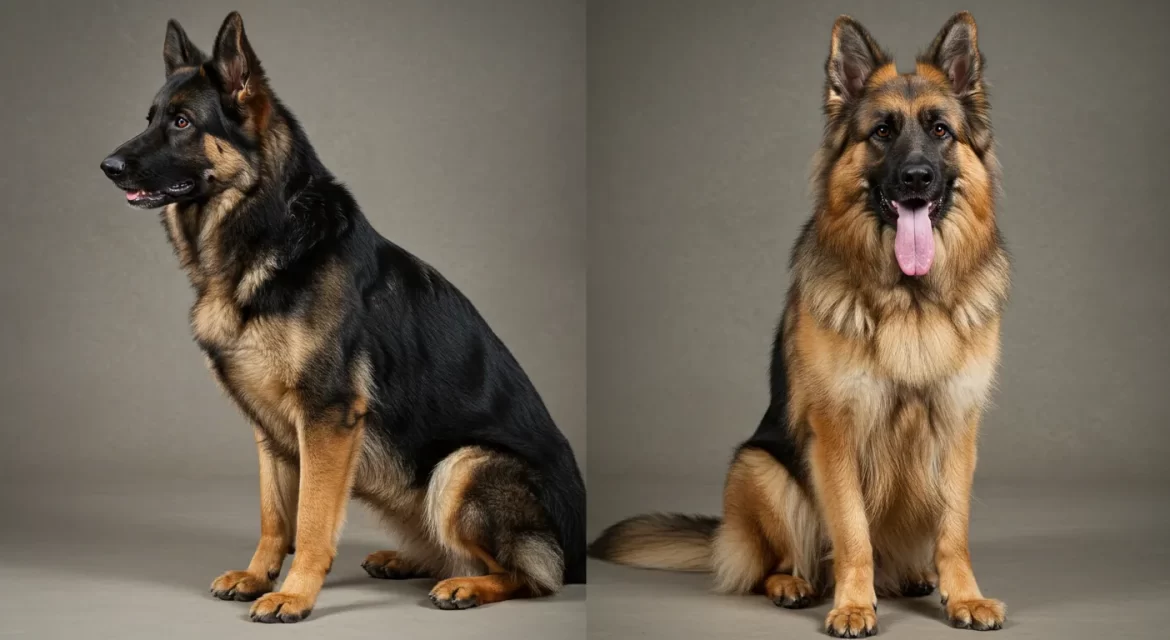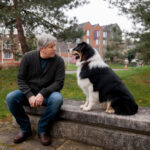If your German Shepherd is constantly leaving a trail of fur around the house, it might be time to look closer at what’s really going on beneath the surface.
Many German Shepherd owners don’t realize that their dog’s grooming needs depends on the types of hair on German Shepherd dogs and that the breed has not just one but three main types of hair to manage. From short hair to long hair types to different color coats, each variation affects how you should groom and care for your dog.
Whether your German Shepherd has a dense undercoat or a flowing outer coat, understanding the unique combination of coat length, thickness, and the color of dog is essential. The ideal coat isn’t just about appearance—it reflects your dog’s overall health and comfort. By recognizing the types of hair and learning how to manage them properly, you can reduce shedding, prevent skin problems, and keep your GSD looking sharp all year round.
Understanding German Shepherd Coat Types
All types of German Shepherd dog breeds have what’s called a double coat. This includes:
| Undercoat | The undercoat, which is thick, velvety, and wool-like, is the layer closest to the skin. Insulation is its primary function, keeping the dog warm in the winter and cool in the summer.
Despite fluctuating weather, this layer helps to keep the body’s internal temperature steady by trapping air near the body. The dog can stay cooler by “blowing the coat,” which is the term for the heavy shedding of the undercoat that occurs during warmer months. The undercoat thickens to offer warmth and protection from the cold throughout the winter months. |
| Topcoat (Guard Hair) | Similar to a natural raincoat, the topcoat, also known as guard hairs, is made up of longer, coarser strands that shield the dog from dirt, dampness, and debris. Rain, snow, and UV rays are all protected from the skin and undercoat by these hairs.
The topcoat prioritizes defense and durability, while the undercoat offers insulation. All German Shepherds have two coats, but there are three primary varieties based on differences in length, density, and texture: short, medium (plush), and long. Each has a different effect on shedding and grooming requirements. |
But while all GSDs share this double coat structure, the length and density of each layer vary. That’s what defines the three main types of German Shepherd coats: short, medium (plush), and long.
1. Short Haired (Standard Coat) German Shepherd
The short-haired or standard-coated German Shepherd is the most common, especially in working and service lines. These dogs have a dense undercoat paired with a topcoat that lies close to the body and feels coarse to the touch. While they may appear low-maintenance compared to their fluffier cousins, they shed consistently throughout the year and go through intense coat blowouts during spring and fall.
Grooming short-haired GSDs is relatively straightforward—brushing once or twice a week is usually enough to keep loose hairs at bay. However, during seasonal shedding, you may need to increase grooming to every other day using a slicker brush or deshedding tool. This coat type is ideal for active individuals or families who want a loyal companion without committing to frequent, high-maintenance grooming.
2. Medium Haired (Plush Coat) German Shepherd
The medium or plush coat is often considered the “in-between” type and is beloved for its fuller, fluffier look. This coat is thicker and slightly longer than the standard coat, with more feathering around the legs and tail, giving the dog a majestic yet rugged appearance. Plush-coated GSDs have a very dense undercoat, which makes them particularly heavy shedders—especially during the two main shedding seasons.
Owners of plush-coated dogs need to brush them at least 2–3 times a week, and daily during blowout periods, to prevent their home from becoming a fur storm. Dog grooming tools like undercoat rakes and pin brushes work best for reaching the dense layers. Though they require more grooming effort, many owners find the bonding time spent brushing their plush-coated shepherds to be rewarding and even therapeutic.
3. Long Haired German Shepherd
Long-haired German Shepherds are famous for having feathery fringes on their legs, ears, and tails in addition to their gorgeous, flowing coats. This coat type may or may not have a thick undercoat, and this greatly affects both grooming needs and shedding levels. Long stock coat dogs with an undercoat will shed almost as much as plush-coated types and require brushing at least 3–4 times a week. Those without an undercoat may shed less but are prone to tangles and mats, particularly behind the ears and around the legs.
Long-haired shepherds need regular grooming using wide-tooth combs, detangling sprays, and dematting tools to keep their coat in good condition. While this coat type is higher maintenance, many people find the beauty and grace of long-haired GSDs worth the extra effort. These dogs are often seen in show lines and are popular for their luxurious appearance and affectionate temperament.
Which is better long coat or short coat German Shepherd?
Each type has benefits. While a long-coated German Shepherd needs more attention and looks thicker and fluffier, a short-coated German Shepherd is easier to care for and requires less maintenance. The decision is based on your preferred style and grooming preferences.
German Shepherd Coat Color
There are different types of coat color found in purebred German Shepherds, each with its own striking appearance—but they all share the same double-coat structure. While color doesn’t directly affect shedding, it can influence how noticeable that shedding is and may have a slight impact on grooming preferences.
1. Black and Tan
This is the most classic and recognizable German Shepherd color. These canines are tan on the legs, chest, and face, and have a black “saddle” on the back. It’s a standard favorite and often what comes to mind when people picture the breed.
2. Black and Red
Similar to black and tan, this variation has richer, deep reddish tones instead of light tan. The red coloring tends to be more vibrant and luxurious, often making black and red German Shepherds popular in show lines.
3. Sable
Sable GSDs have individual hairs that are banded in multiple colors (typically black-tipped over tan or red). Their appearance can range from light to dark, and the color pattern can shift as they mature. They tend to shed a lot, especially during seasonal coat changes.
4. Solid Black
Solid color dogs are entirely black from head to tail and often look sleeker due to the uniform coat. Their grooming needs are similar to other types, but shedding may be less noticeable on dark clothing and furniture.
5. Bi-Color
Bi-color German Shepherds are mostly black with minimal tan markings—usually just on the legs and possibly above the eyes. This color gives them a dramatic and bold appearance.
6. Liver and Blue
These rare coat colors are caused by recessive genes. Liver GSDs have a chocolate-brown coat, while blue GSDs have a steel-gray tone. Though beautiful, these colors are not accepted in some show standards. Their grooming is the same, but lighter shades may show dirt more easily.
7. White
White German Shepherds are striking and elegant, with snow-white coats. While they shed just as much as others, the white hair tends to be more visible around the house. Regular brushing is a must to manage the shedding and keep their coat looking clean.
8. Panda
Panda GSDs are genetically unique and have a mix of white, black, and tan patches. They’re not albino and are considered rare. Grooming these dogs is more about managing shedding evenly across multiple color patches.
What is the exotic color of the German Shepherd?
German Shepherds with the diluted liver color known as Isabella are uncommon and unique. The distinctive light brown or beige coat of the Isabella German Shepherd appears slightly worn. This pigment, which is less prevalent than the usual black and tan or sable varieties, is caused by a recessive gene.
What Age Do German Shepherd Dogs Get Their Full Coat?
German Shepherds usually take around 2 to 3 years to achieve their full adult coat. When their puppy coat starts to shed at the age of six months, this process commences.
Coat Development Timeline:
- Puppy Coat (Up to 6 Months):
When German Shepherds are born, they have a soft, fine puppy coat. Around four to six months of age, this coat will start to progressively shed to make room for their adult fur. During this time, they may look a bit scruffy, and regular grooming can help manage the shedding. - Adult Coat (1 to 2 Years):
By the time they are one year old, the German Shepherd’s coat will have started to transition to a thicker, more textured adult coat. However, the coat won’t fully develop until they are around 2 years old. Their fur will become denser, and they may experience heavier shedding cycles, especially during seasonal changes. - Final Coat (2 to 3 Years):
Between the ages of 2 and 3 years, German Shepherds reach their full adult coat. The coat is now thicker, with a more structured look that matches their strong build. Their fur may become shinier, and the shedding should level out into a more manageable pattern.
Long-haired puppies often don’t show their final coat length until over a year old, and plush-coated pups might appear scruffy during their transitional period. Be patient — the transformation is worth it.
What Is the Seasonal Shedding Pattern for German Shepherds?
GSDs are famously heavy shedders. But twice a year, they shed so much you might wonder how they still have any fur left!
“Blowing Coat” Explained:
-
Spring: German Shepherds remove their heavy undercoats in anticipation of warmer weather when the temperature rises.This shedding can be heavy and often requires more frequent grooming to keep up with the loose fur.
-
Fall: German Shepherds grow a thicker winter undercoat and shed their lighter summer coat in anticipation of cooler temperatures. Like spring shedding, this can also be intense, and regular brushing helps manage the fur.
This process, known as “blowing their coat,” can last 2–4 weeks and may require daily brushing to manage fur around your home. You’ll find clumps of hair everywhere — on furniture, clothes, even floating through the air.
Grooming Needs Based on Coat Type
Your grooming routine should be tailored to your German Shepherd’s specific coat. Here’s a breakdown:
Depending on your pet’s coat type and color, grooming requirements can change. While pets with short coats might require less upkeep, animals with long or thick coats need to be groomed more frequently to avoid matting and tangles. How frequently your pet has to be groomed can also be influenced by the color of their coat.
Can Coat Type Affect Skin Health in German Shepherds?
Absolutely. The type of coat your dog has can influence their skin’s vulnerability to irritation, skin allergies, and infection.
- Long-haired GSDs: More likely to develop mats that trap moisture, dirt, and debris — which can lead to skin infections if not groomed thoroughly and regularly.
- Short-haired GSDs: Although easier to maintain, they offer less protection from UV rays and may be more prone to skin allergies due to greater exposure.
- Thick undercoats: Can hide rashes, hotspots, and parasites if not checked during grooming.
Pro Tip: Always part the coat and inspect the skin regularly for redness, flaking, scabs, or signs of fleas/ticks. Regular grooming is not just about beauty — it’s about health.
Click to read more about best dog food for german shepherds with skin allergies.
Conclusion: Your German Shepherd’s Coat is a Window to Their Well-being
Your German Shepherd’s coat is truly a window to their overall well-being. While they aren’t low-maintenance pet, the love and loyalty they offer make every grooming session worthwhile. Understanding your GSD’s specific outer coat and the color of your dog helps you tailor their care, manage heavy shedding, and protect their skin health.




